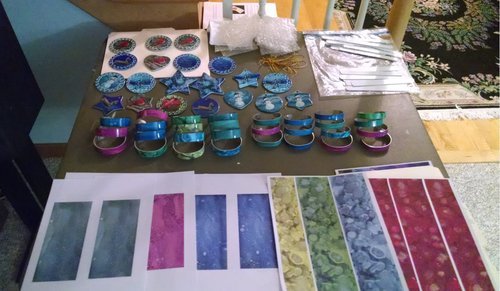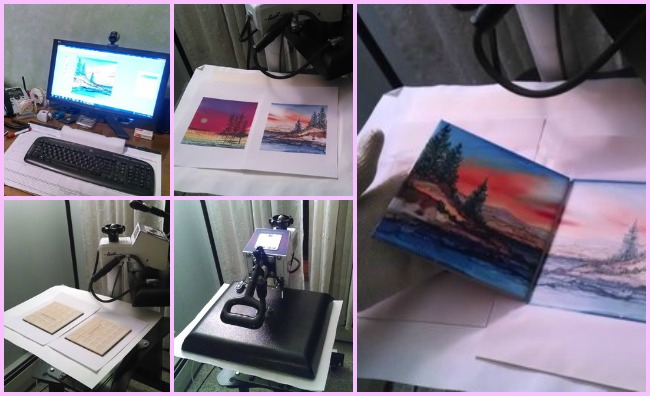by Carolyn Edlund
Printing technology has a new place in the studio, creating efficiency and expanding opportunities.

Artist Linda Flynn is able to offer numerous products using her paintings printed on different surfaces.
I recently spoke with artist Linda Flynn, who started out as a painter. As her business concept evolved, she needed a more efficient way to create work for sale. She embraced technology in her studio, and now sells her 2D artwork on many products through the use of sublimation printing. Taking this step means she is now poised to enter new marketplaces for her work. She is ready to build a strong business with potential to sell volume and gain repeat orders.
I asked her how she got started.
“Five years ago I was participating in many weekend art and craft shows,” she said. “I was doing face painting and selling my acrylic paintings, prints and notecards. I saw a YouTube video on painting with alcohol inks on ceramic tiles and decided to add that to my booth.”
This led to a change in her medium, but she realized she couldn’t do everything she wanted by hand in the studio.
“I first started doing abstract scenes, which became flowers and landscapes. I sold them as coasters and decorative tiles,” she explained. “The tiles quickly became popular and I started painting tons and tons of them. After a while I felt I was painting the same thing over and over again.”
Her first solution to this dilemma was to print out her artwork. Then she decoupaged those prints onto ceramic tiles, and sealed them. But that process turned out to be long, tedious and impractical. So she did some more research.

The sublimation process: Transfer images are printed from digital format. Blank tiles are placed on the printer, and pressurized heat is used to place the image on the tile. The dyes are changed into a gas which penetrates the surface of the substrate, making it permanent.
Embracing a new technique
“I read up on Dye Sublimation printing on the internet, and found a company online that will take art and print it on tiles. I sent this company some samples of my art and final results were breathtaking! The tiles were absolutely beautiful, glossy, vibrant and glowing. I was hooked on the whole thing.”
Eventually, Linda Flynn and her husband purchased their own sublimation printing equipment. They estimate the startup cost for the setup requires an investment of about $2,000 – $3,000.
Her entire business has been transformed due to the efficiency and capability of sublimation printing. This means she can place prints of her original images on many different surfaces. Opportunities to sell have opened up.
“Now that we can produce tiles more quickly, I plan on selling wholesale,” she said. “We have increased our presence in more retail stores in our area. My husband will be going full time into the wholesale business, and I plan to join him soon.
Their product line has expanded to coasters, ceramic tiles, trivets, decorative art, cuff bracelets, and Christmas ornaments. Ceramic mugs will be coming soon. She plans to learn how to use dye sublimation for fabric printing as well. This will enable her to add whole new categories of products for her brand.
Creating items in your own production studio means that you have to take orders, make all product, hold inventory, pack and ship, and invoice customers. It is a far cry from leveraging your designs by selling through print-on-demand providers. Instead of the payment that POD offers artists (usually about 10%), you are paid the full price for the product, either at wholesale or retail depending on how you sell.
This technology isn’t for everyone. But for artists with big plans to expand and get into production, it can be a perfect match. Dye sublimation would not be useful for 2D artists who only want to create reproductions. However, the range of options for printing on different surfaces is where this process shines.
“Depending on your art, the dye sublimation process is a great way of getting your artwork onto functional objects,” said Flynn. And that is a great way to build a production business with expanded horizons in mind.
Visit Linda Flynn’s website and see products created with dye sublimation in her Etsy shop.



Nice! As your business evolves you may find that some of these processes/duties can be delegated to assistants. This could free you to take on the aspects of the business that are best suited to your talents (such as prototype designs and marketing).
There may also be a side business in doing similar printing for other artists.
Congratulations!
Thanks James,
Yes, a few good ideas. My husband does help out right now. He does all the printing and packaging.
I have thought about offering my services to other artists that want their images sublimated.
That is a real possibility for the future!
Linda,
I am an artist with a dozen or so paintings from which I am currently making prints and notecards as are many artists, I know. I would very much like to add some trivets and/or wall tiles, but have no idea how to go about that. In researching online, I came upon this site/ article. I would be very interested if you could do some printings or could lead me to someone who does. Thank you,
Diana, you might check out Color Bakery, which does offer this type of services for artists http://www.colorbakery.com/special_services.html
Thank you, Carolyn. I will check it out! Diana
I am very interested in sublimation to use with my art. I currently hand paint wood ornaments. Do you have any experience with heat transfer paper on wood. I thought this might be a less expensive way to reproduce art on wood.
Lynn, I don’t have a specific answer for you to that question, but am doing an interview with a printing expert on July 6, 2021. She will be taking questions. It’s a free event, and you can learn more here https://www.facebook.com/events/185155333530414